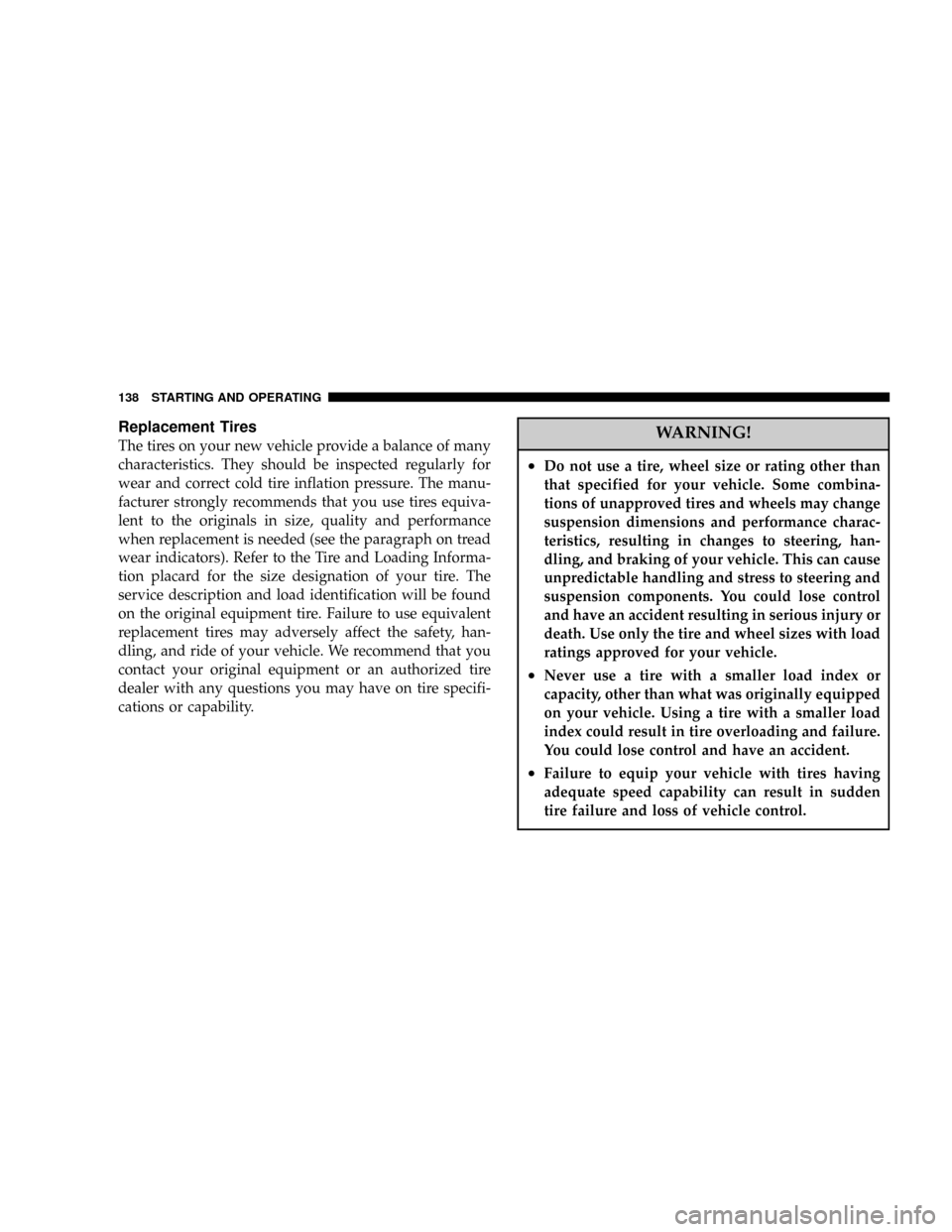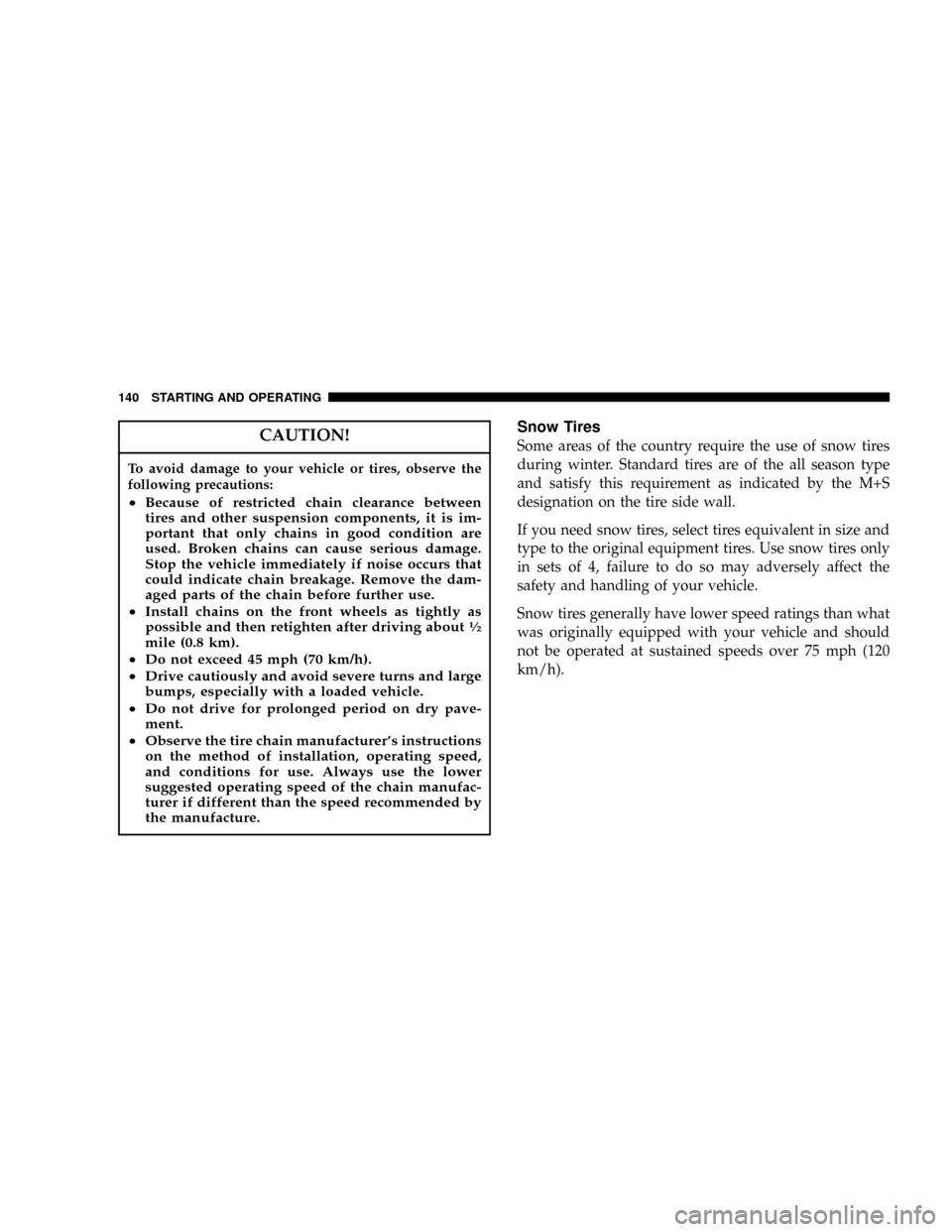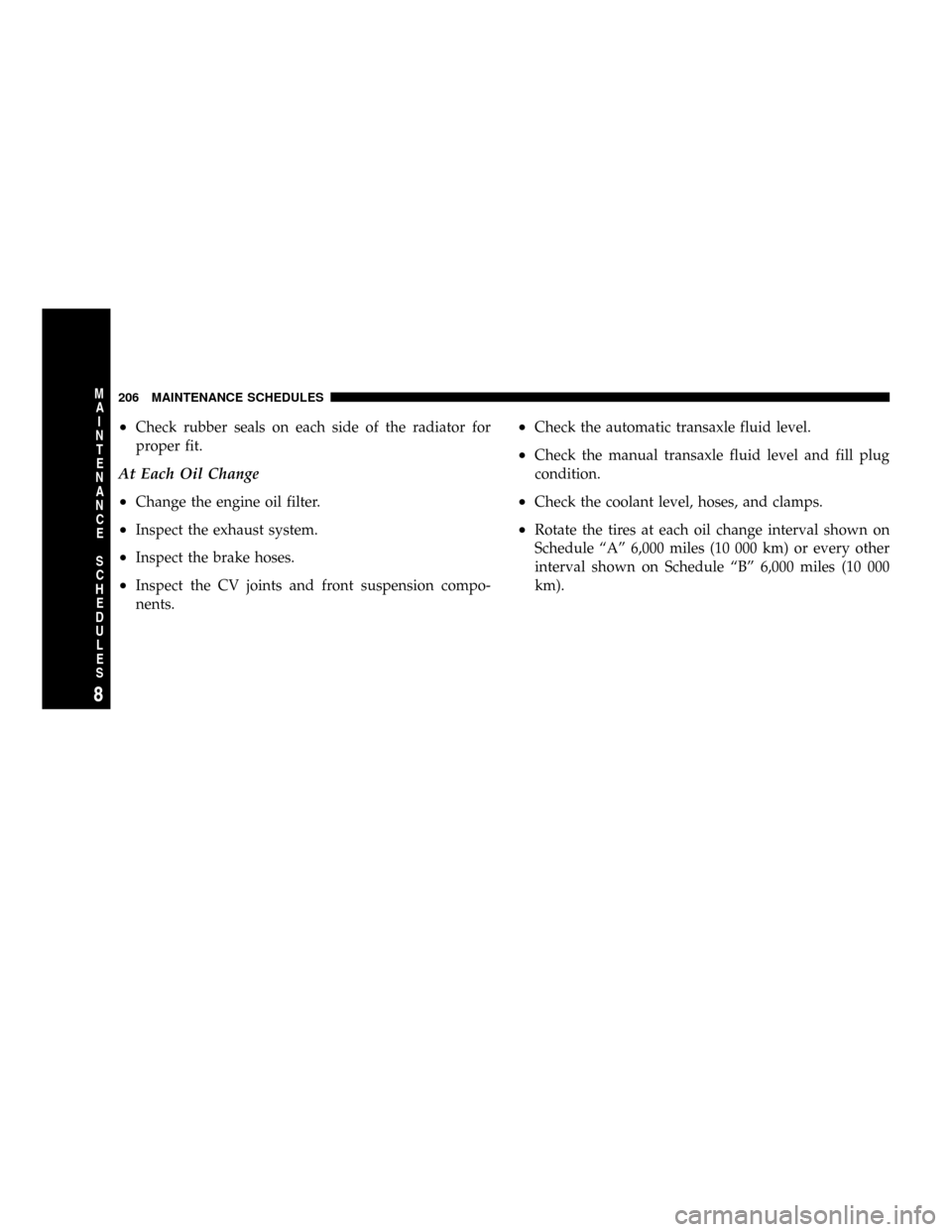suspension DODGE NEON 2004 2.G Owners Manual
[x] Cancel search | Manufacturer: DODGE, Model Year: 2004, Model line: NEON, Model: DODGE NEON 2004 2.GPages: 241, PDF Size: 3.75 MB
Page 138 of 241

Replacement Tires
The tires on your new vehicle provide a balance of many
characteristics. They should be inspected regularly for
wear and correct cold tire inflation pressure. The manu-
facturer strongly recommends that you use tires equiva-
lent to the originals in size, quality and performance
when replacement is needed (see the paragraph on tread
wear indicators). Refer to the Tire and Loading Informa-
tion placard for the size designation of your tire. The
service description and load identification will be found
on the original equipment tire. Failure to use equivalent
replacement tires may adversely affect the safety, han-
dling, and ride of your vehicle. We recommend that you
contact your original equipment or an authorized tire
dealer with any questions you may have on tire specifi-
cations or capability.WARNING!
²Do not use a tire, wheel size or rating other than
that specified for your vehicle. Some combina-
tions of unapproved tires and wheels may change
suspension dimensions and performance charac-
teristics, resulting in changes to steering, han-
dling, and braking of your vehicle. This can cause
unpredictable handling and stress to steering and
suspension components. You could lose control
and have an accident resulting in serious injury or
death. Use only the tire and wheel sizes with load
ratings approved for your vehicle.
²Never use a tire with a smaller load index or
capacity, other than what was originally equipped
on your vehicle. Using a tire with a smaller load
index could result in tire overloading and failure.
You could lose control and have an accident.
²Failure to equip your vehicle with tires having
adequate speed capability can result in sudden
tire failure and loss of vehicle control.
138 STARTING AND OPERATING
Page 139 of 241

CAUTION!
Replacing original tires with tires of a different size
may result in false speedometer and odometer read-
ings.
Alignment And Balance
Poor suspension alignment may result in:
²Fast tire wear.
²Uneven tire wear, such as feathering and one-sided
wear.
²Vehicle pull to right or left.Tires may also cause the vehicle to pull to the left or right.
Alignment will not correct this condition. See your dealer
for proper diagnosis.
Improper alignment will not cause vehicle vibration.
Vibration may be a result of tire and wheel out-of-
balance. Proper balancing will reduce vibration and
avoid tire cupping and spotty wear.
Tire Chains
If driving conditions require tire chains for your vehicle,
chains that meet SAE class ªSº requirements can be used,
but they must be installed on tire sizes P175/70R14,
185/65R14, P185/65R14, 185/60R15, or P185/60R15 tires.
Contact your local dealership or tire dealer for these tire
sizes.
STARTING AND OPERATING 139
5
Page 140 of 241

CAUTION!
To avoid damage to your vehicle or tires, observe the
following precautions:
²Because of restricted chain clearance between
tires and other suspension components, it is im-
portant that only chains in good condition are
used. Broken chains can cause serious damage.
Stop the vehicle immediately if noise occurs that
could indicate chain breakage. Remove the dam-
aged parts of the chain before further use.
²Install chains on the front wheels as tightly as
possible and then retighten after driving about1¤2mile (0.8 km).
²Do not exceed 45 mph (70 km/h).
²Drive cautiously and avoid severe turns and large
bumps, especially with a loaded vehicle.
²Do not drive for prolonged period on dry pave-
ment.
²Observe the tire chain manufacturer's instructions
on the method of installation, operating speed,
and conditions for use. Always use the lower
suggested operating speed of the chain manufac-
turer if different than the speed recommended by
the manufacture.
Snow Tires
Some areas of the country require the use of snow tires
during winter. Standard tires are of the all season type
and satisfy this requirement as indicated by the M+S
designation on the tire side wall.
If you need snow tires, select tires equivalent in size and
type to the original equipment tires. Use snow tires only
in sets of 4, failure to do so may adversely affect the
safety and handling of your vehicle.
Snow tires generally have lower speed ratings than what
was originally equipped with your vehicle and should
not be operated at sustained speeds over 75 mph (120
km/h).
140 STARTING AND OPERATING
Page 155 of 241

CAUTION!
Do not attempt to raise the vehicle by jacking on the
crossmember below the radiator or on the front
suspension crossmember.
3. Jack saddle support must be positioned in between
locating darts at the front of the vehicle and behind
locating dart at the rear. Turn the jack screw to the right
until the jack head is properly engaged with the lift area
closest to the wheel to be changed.Do not raise the vehicle until you are sure the jack is
securely engaged.
4. Raise the vehicle by turning the jack screw to the right.
Raise the vehicle only until the tire clears the surface.
Miminum tire lift provides maximum vehicle stability.
WHAT TO DO IN EMERGENCIES 155
6
Page 163 of 241

MAINTAINING YOUR VEHICLE
CONTENTS
m2.0L Engine Compartment...............165
mOnboard Diagnostic System Ð OBD II......166
mEmissions Inspection And Maintenance
Programs
............................167
mReplacement Parts.....................168
mDealer Service........................168
mMaintenance Procedures.................169
NEngine Oil..........................169
NIgnition Wiring System.................174
NCrankcase Emission Control System........174
NFuel Filter..........................175
NAir Cleaner Element (Filter)..............175NMaintenance-Free Battery................175
NAir Conditioner......................176
NPower Steering Fluid Check..............177
NFront Suspension Ball Joints..............178
NBody Lubrication.....................178
NWindshield Wiper Blades................178
NWindshield Wiper Blade Replacement.......179
NWindshield Washer Aiming..............179
NWindshield Washer Reservoir.............179
NExhaust System......................179
NCooling System.......................180
7
Page 178 of 241

If necessary, add fluid to restore to the proper indicated
level. With a clean cloth, wipe any spilled fluid from all
surfaces. Refer to Recommended Fluids, Lubricants, and
Genuine Parts for correct fluid types.
Front Suspension Ball Joints
There are two front suspension lower ball joints that are
permanently lubricated. Inspect these ball joints when-
ever under-vehicle service is done. Damaged seals
should be replaced to prevent leakage or grease contami-
nation.
Body Lubrication
Locks and all body pivot points, including such items as
seat tracks, doors, trunk and hood hinges, should be
lubricated periodically to assure quiet, easy operation
and to protect against rust and wear. Prior to the appli-
cation of any lubricant, the parts concerned should be
wiped clean to remove dust and grit; after lubricating
excess oil and grease should be removed. Particular
attention should also be given to hood latching compo-
nents to insure proper function. When performing other
underhood services, the hood latch, release mechanism
and safety catch should be cleaned and lubricated.The external lock cylinders should be lubricated twice a
year, preferably in the fall and spring. Apply a small
amount of a high quality lubricant such as MopartLock
Cylinder Lubricant directly into the lock cylinder.
Windshield Wiper Blades
Clean the rubber edges of the wiper blades and the
windshield periodically with a sponge or soft cloth and a
mild non abrasive cleaner, or use the washer solvent. This
will remove accumulations of salt or road film and help
reduce streaking and smearing.
Operation of the wipers on dry glass for long periods
may cause deterioration of the wiper blades. Always use
washer fluid when using the wipers to remove salt or dirt
from a dry windshield. Avoid using the wiper blades to
remove frost or ice from the windshield. Make sure that
they are not frozen to the glass before turning them on to
avoid damaging the blade. Keep the blade rubber out of
contact with petroleum products such as engine oil,
gasoline, etc.
178 MAINTAINING YOUR VEHICLE
Page 206 of 241

²Check rubber seals on each side of the radiator for
proper fit.
At Each Oil Change
²
Change the engine oil filter.
²Inspect the exhaust system.
²Inspect the brake hoses.
²Inspect the CV joints and front suspension compo-
nents.
²Check the automatic transaxle fluid level.
²Check the manual transaxle fluid level and fill plug
condition.
²Check the coolant level, hoses, and clamps.
²Rotate the tires at each oil change interval shown on
Schedule ªAº 6,000 miles (10 000 km) or every other
interval shown on Schedule ªBº 6,000 miles (10 000
km).
206 MAINTENANCE SCHEDULES
8
M
A
I
N
T
E
N
A
N
C
E
S
C
H
E
D
U
L
E
S
Page 233 of 241

Emission Control System Maintenance....167,204
Engine............................... 165
Break-In Recommendations............... 46
Checking Oil Level.................... 169
Compartment........................ 165
Cooling............................ 180
Exhaust Gas Caution.................. 145
Jump Starting........................ 157
Oil ..........................169,200,201
Oil Change Interval................... 170
Oil Filter............................ 201
Oil Selection......................... 171
Oil Synthetic......................... 172
Overheating......................... 152
Temperature Gauge.................... 82
Timing Belt.......................... 174
Engine Oil Viscosity Chart................ 171
Exhaust Gas Caution..................47,145
Exhaust Pipes......................... 179
Exhaust System........................ 179
Extender, Seat Belt....................... 31Filters
Air Cleaner.......................... 175
Automatic Transaxle................... 189
Engine Fuel......................... 175
Engine Oil.......................172,201
Flashers
Hazard Warning...................... 152
Flooded Engine Starting.................. 115
Fluid, Brake........................... 201
Fluid Capacities........................ 200
Fluid Leaks............................ 48
Fluid Level Checks
Automatic Transaxle................... 187
Manual Transaxle..................... 189
Fog Lights...........................62,78
Folding Rear Seat....................... 57
Freeing A Stuck Vehicle.................. 160
Front Suspension Ball Joints............... 178
Fuel..............................141,201
Adding............................. 145
Capacity............................ 200
Filler Cap........................... 145
Filter.............................. 175
INDEX 233
10